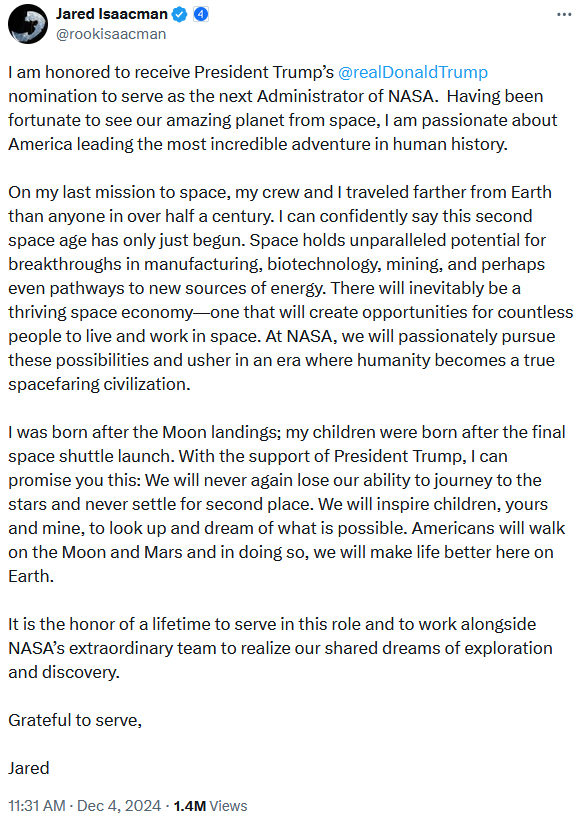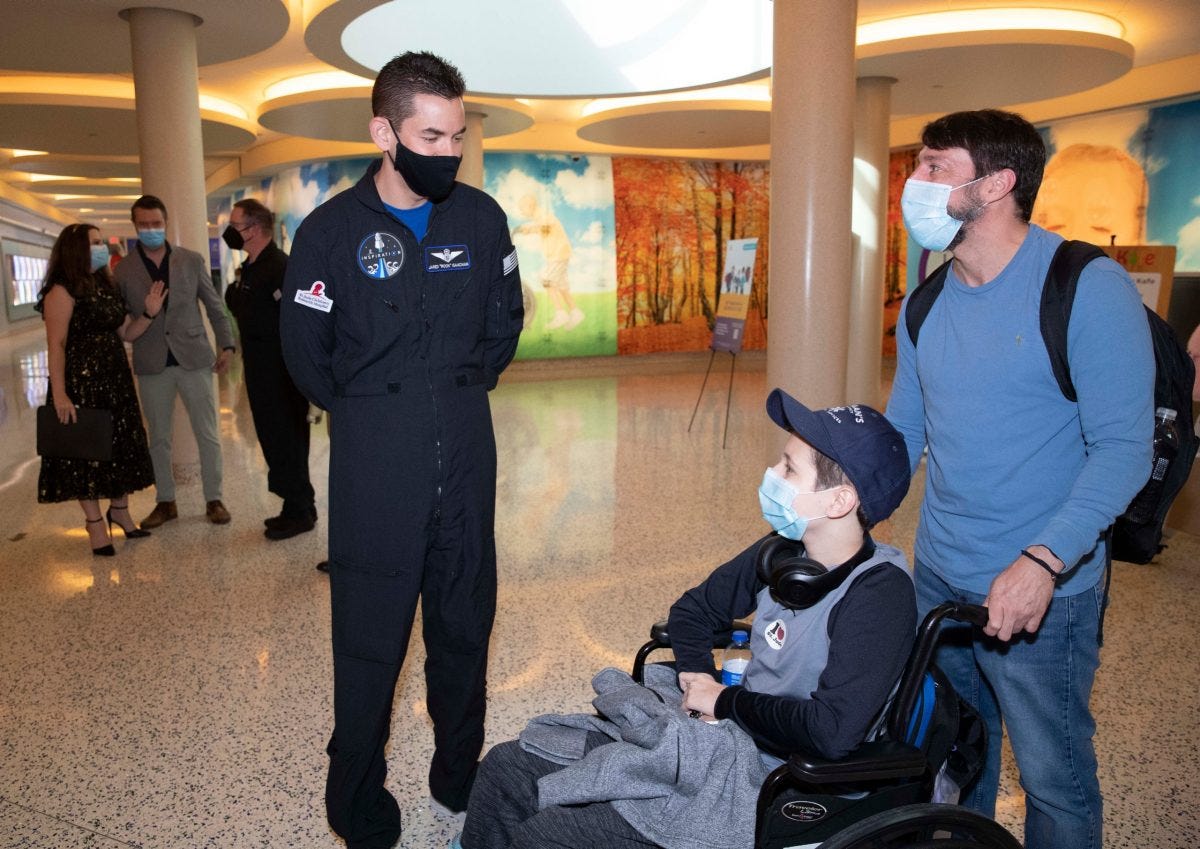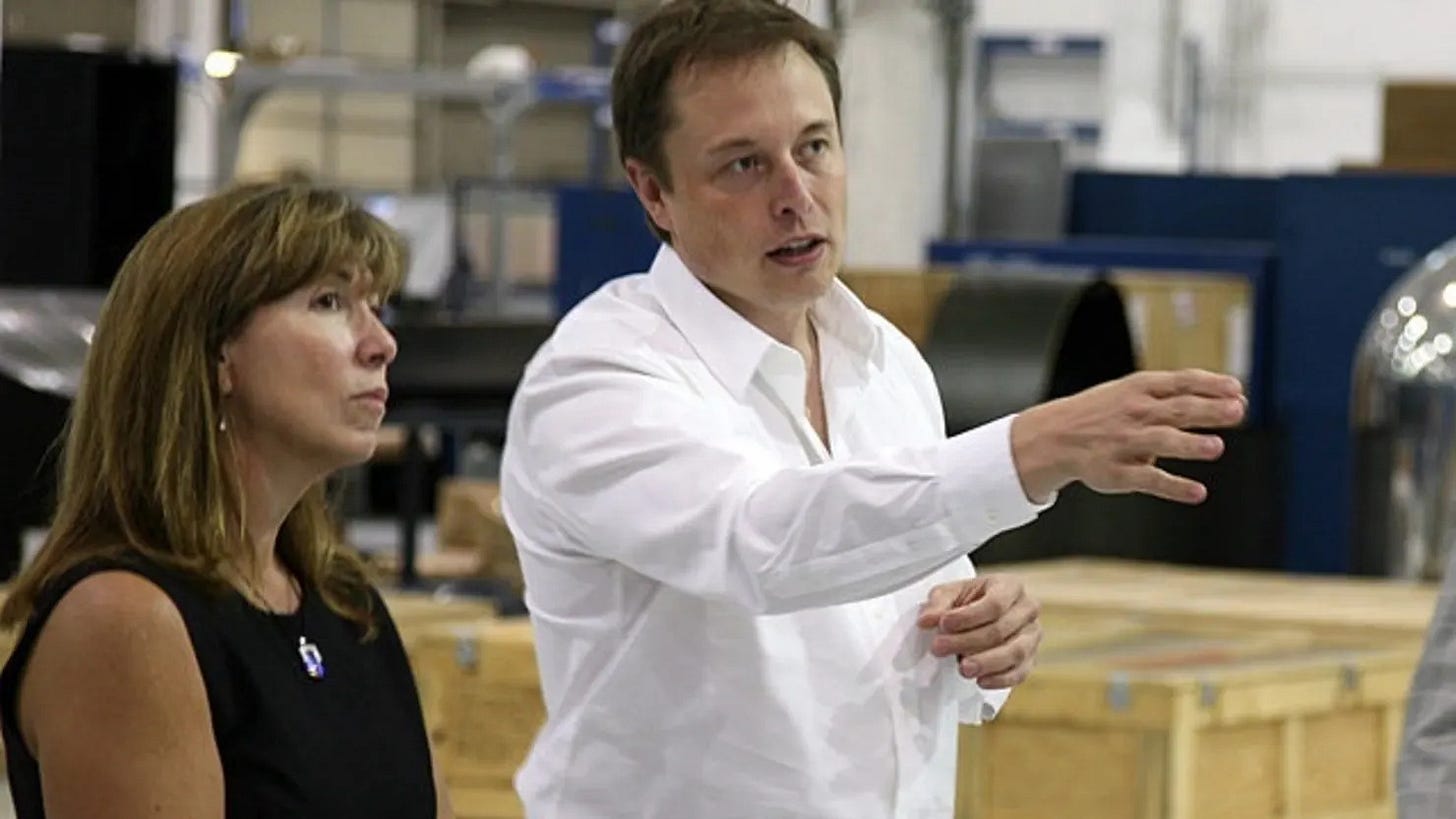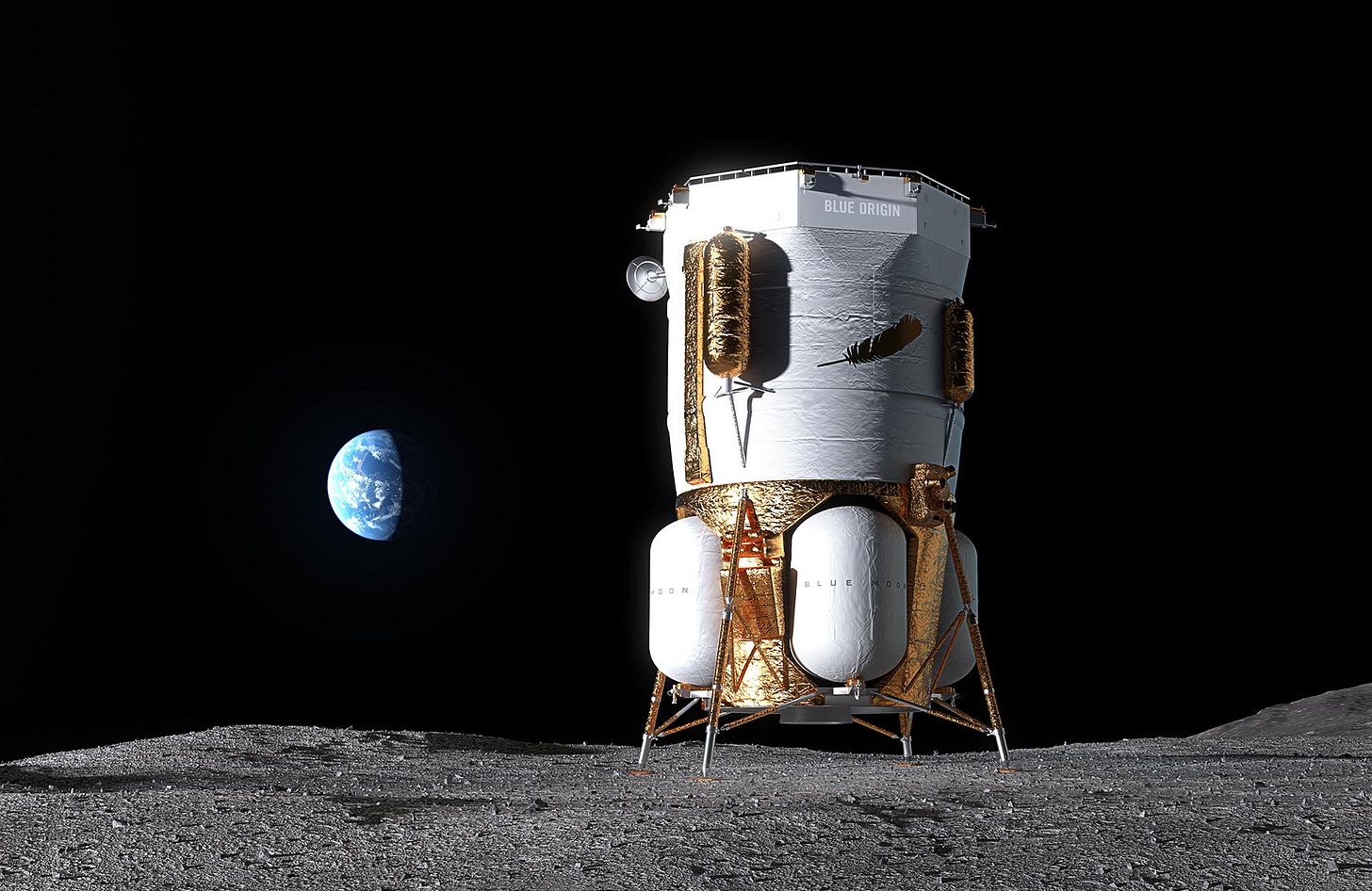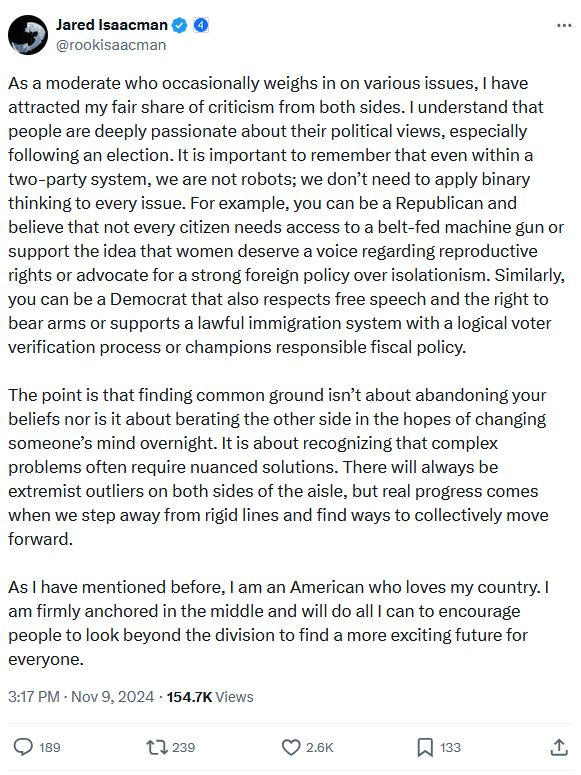The Space Philanthropist
Can Jared Isaacman Change How Congress Views NASA?
Jared Isaacman and the Inspiration4 crew were interviewed by NBC News for a special that aired on May 1, 2021.
Full disclosure … I think Donald Trump is a despicable human being. He belongs in prison. He was a terrible president, and I think he’ll be terrible again come January 20, 2025.
That said, Trump rocked the space industry when he announced on December 4, 2024 that he will nominate billionaire space philanthropist Jared Isaacman to be NASA’s next administrator.
Here’s what Isaacman posted on X yesterday after the nomination was announced.
Those unfamiliar with Jared, especially outside the space biz, have reflexively assumed that he’s just another corrupt billionaire Trump crony, a tool of Elon Musk’s schemes to monopolize the American space industry.
I can’t speak to what’s in Elon’s mind these days (who can?), but as for Jared I have no worries.
What does a NASA administrator do, anyway?
Here’s what §20111 of the National Aeronautics and Space Act, NASA’s charter says:
The Administration shall be headed by an Administrator, who shall be appointed from civilian life by the President by and with the advice and consent of the Senate. Under the supervision and direction of the President, the Administrator shall be responsible for the exercise of all powers and the discharge of all duties of the Administration and shall have authority and control over all personnel and activities thereof.
It also says that the administrator “shall not engage in any other business, vocation, or employment while serving as such.”
NASA has had fourteen congressionally approved administrators in its 66-year history. Many of them had careers in public service. Three had flown in space. Some came from the private sector and, having been successful in business, were most likely affluent.
Isaacman is unique. He’ll be the first billionaire administrator, if Congress consents. He’s flown in space, but not with NASA — he’ll be the first commercially flown astronaut.
Jared Isaacman and the Inspiration4 crew visit St. Jude Children’s Hospital in 2021. Image source: St. Jude Children’s Hospital.
More importantly to humanity, Jared is philanthropic with his money. He personally donated $125 million to St. Jude Children’s Hospital, and paid for the Inspiration4 commercial flight that raised $243 million for the charity. That included $55 million from Elon Musk, on whose spacecraft they flew.
Here on the Space Coast, Jared wowed the locals by donating an undisclosed amount in May this year to the US Space Force Historical Foundation. Although the amount was undisclosed, it was described as the largest donation in the foundation’s history. The foundation chair described the amount as “unbelievable.”
The foundation announced in November its interest in leasing a Port Canaveral landmark, Exploration Tower, for conversion into an immersive public learning center showcasing "the past, present and future of space exploration,” funded by Isaacman’s donation.
Jared Isaacman goes outside his crew Dragon on September 12, 2024 to conduct the first commercial spacewalk, along with SpaceX senior space operations engineer Sarah Gillis. Image source: Polaris Program Flickr webpage.
Isaacman also funded September’s Polaris Dawn mission that launched Kennedy Space Center’s history launch pad 39A. As with Inspiration4, Jared commanded Polaris Dawn, achieving the highest altitude attained by humans since Apollo 17, as well as performing the first commercial spacewalk. The Polaris program also raises money for St. Jude, although they’ve yet to disclose how much was raised by this mission.
According to the Polaris website, Isaacman’s program “is a first-of-its-kind effort to rapidly advance human spaceflight capabilities … The Polaris Program seeks to demonstrate important operational capabilities that will serve as building blocks to help further human exploration to the Moon, Mars, and beyond.”
Jared is worth about $1.6 billion, according to the Forbes website. He made his fortune by developing an online payment processing service that he started at age 16. He also founded a US Air Force pilot training company that owns the world’s largest fleet of military aircraft. Isaacman sold a majority interest in that company in 2019.
Forbes profiled him in November 2020. Jared took up aviation as a hobby, starting with prop planes, working his way up to flying jets. He raised $100,000 for the Make-A-Wish Foundation by flying two round-the-world speed flights in 2008 and 2009.
I’ve read baseless allegations by some in social media claiming (without evidence) that Isaacman is a tool of Elon Musk, who will somehow manipulate the man into giving all NASA business to SpaceX.
That is rubbish. There’s no evidence that Isaacman is a close friend of Musk, much less his dupe. Quite to the contrary, Jared is Elon’s customer. Jared and his crews have helped SpaceX demonstrate its technologies by flying crew Dragon higher than ever before, taking the first SpaceX spacewalk, and demonstrating the SpaceX extravehicular spacesuits. Perhaps that’s why Elon gave $55 million to Jared’s favorite charity.
Isaacman’s goal is to evolve humanity’s spacefaring capabilities. Right now, the only way to do that in the United States is via SpaceX. Other vendors have yet to emerge. Years ago, Boeing had an agreement to fly commercial crews to the planned Bigelow Aerospace commercial habitat, as well as the International Space Station. Bigelow went out of business, and Boeing’s Starliner still has bugs to fix. Billionaire Jeff Bezos’ Blue Origin might fly crew one day on its New Glenn, but that rocket has yet to fly a demonstration flight from Cape Canaveral. So if Jared wants to go to space to push the technology and raise money for charities, he has to do so through SpaceX.
Jared made just that point in an October 18 Twitter/X post. “In many cases, it is not about how good SpaceX is, but how bad the legacy players have become.” He called for many more companies like SpaceX, not a Musk monopoly.
In recent posts on Twitter/X, Isaacman endorsed Musk’s idea for a government efficiency commission. Regarding space, Isaacman wrote, “Encourage risk-taking and disruption: Need to get the focus back where it belongs and ensure the next SpaceX—or any company looking to change the game—doesn’t have to sue its way into fair competition.” (That’s what SpaceX had to do, a decade ago.) He also called for breaking up “the largest primes to foster a more competitive and innovative defense industry,” although he acknowledged that’s probably unrealistic.
There’s no evidence that Isaacman is a rabid Trump supporter, much less “MAGA.” His campaign contributions can be researched on the Open Secrets website. Over the years, he’s given to Republicans and Democrats; his largest contributions were $100,000 in 2021 to the Democratic Senate Majority PAC, and $50,000 in 2022 to Democratic candidate Josh Shapiro’s Pennsylvania governor campaign. There’s no listing of any contribution to Trump’s campaigns.
The closest analogy to Isaacman’s profile would be Lori Garver, NASA’s deputy administrator during President Barack Obama’s first administration. A space evangelist like Isaacman, Garver was the executive director of the National Space Society for nine years, then joined NASA in 1998 as an associate administrator for policy and planning. Lori was Obama’s space policy advisor during his 2008 presidential campaign, and convinced him to chart a reformist course injecting competition and innovation into what had become a sclerotic inbred acquisition process. After he was elected president, Obama appointed Garver deputy administrator, serving with former astronaut Charlie Bolden, who was named administrator.
President Barack Obama tours the SpaceX Cape Canaveral launch site with Elon Musk on April 15, 2010. Image source: NASA.
Garver is widely considered to be the principal architect of the revolutionary legislation introduced by the Obama administration in February 2010 that directed NASA to rely on commercial competition for launch services, cancelling the Constellation program that was years behind schedule and billions over budget.
Congress, however, viewed Constellation as a pork program that brought dollars and jobs to their districts and states. In the end, the White House agreed to a compromise that created another “OldSpace” vehicle called Space Launch System (SLS). Congress required NASA to use Space Shuttle and Constellation technologies and contractors for SLS, without competitive bid. In exchange, NASA could proceed with its “NewSpace” Commercial Cargo and Crew programs, awarding prize moneys to companies that achieved specific milestones advancing space technologies. In contrast, Congress forbade NASA from using any new technologies to build SLS unless the agency had no choice — all in the name of protecting legacy contractors and their employees who vote in local elections.
Lori Garver tours the SpaceX factory in Hawthorne, California with Elon Musk in September 2010. Image source: CNBC.
In a December 4 Twitter/X post, Garver applauded Isaacman’s appointment, calling it “terrific news.”
Four key senators, led by Bill Nelson (D-FL) and Kay Bailey Hutchison (R-TX), crafted the compromise bill that required NASA to build SLS. Critics called it the Senate Launch System, because it had been crafted by Congress, not NASA.
Fourteen years later, SLS has flown once. A May 2024 NASA Office of the Inspector General report estimates that, by September 2025, the agency will have spent $55 billion on SLS, the Orion crew vehicle, and associated ground systems. NASA announced on December 5 that the next SLS launch, called Artemis II, is now expected to fly no earlier than April 2026, 3 1/2 years since Artemis I.
The events of 2010 are a template for what to expect should Isaacman attempt what one recent pundit called “Garveresque” reforms. Will Congress rebel if Isaacman tries to cancel SLS, as did Garver with Constellation?
The politicians who created SLS are no longer in office. Bill Nelson, appointed by President Joe Biden in 2021, is NASA’s current administrator. He will depart in January, the last vestige of the SLS founders.
The question for 2025 is if anyone in Congress still cares about SLS. Florida’s two Republican senators haven’t played significant roles in protecting SLS. Marco Rubio, the senior senator, has been nominated by Trump to be Secretary of State. Rick Scott, just re-elected, hasn’t shown much interest in space affairs either.
The one to watch, in my opinion, is Senator Ted Cruz (R-TX). Cruz is an odious person, but he has a genuine interest in space, NewSpace in particular. In times past, he chaired the Senate space subcommittee. In this session, he’s the ranking member of the foreign relations commitee. With Republicans controlling the Senate next year, watch to see if he looks for a seat on the appropriations committee, which controls NASA’s purse. Cruz may have Johnson Space Center in his state, but he also has the SpaceX Starbase in Boca Chica, where Starship launches.
It’s possible that the Trump administration may try to eliminate SLS through Musk’s Department of Government Efficiency (DOGE) commission, but personally I don’t give DOGE much credibility. Despite the title, it’s a strictly advisory entity, and won’t even produce a report until summer 2026, when Congress will be in recess. That fall, Congress will be out campaigning for mid-term elections, so it’s unlikely they’ll be inclined to take up Elon’s recommendations.
SLS will be tough to kill, but it’s a far weaker opponent than it was a decade ago.
It’s also too soon to conclude that the SpaceX Starship, the Blue Origin New Glenn, or other commercial vendors are ready to step in for crewed lunar missions. Starship has flown some spectacular test flights, but it’s far from operational. We’re a long way from SpaceX demonstrating that Starship can vertically land on and launch from a cratered lunar regolith. The Blue Origin Blue Moon cargo lunar lander is still in the design phase, but there are no immediate plans for it to fly people.
An artist’s concept of the Blue Origin Blue Moon cargo lunar lander. Image source: Blue Origin.
My guess is that a compromise will be found. A cap could be placed on SLS, ending the program after five missions or so. That will avoid the shock to the Space Coast local economy that occurred in 2010, when Constellation was proposed for cancellation during the Great Recession. With Shuttle coming to an end, locals incorrectly viewed Constellation as a job saver, when in reality those jobs weren’t going to come online for many years.
A cap of five missions, let’s say to 2030, would buy time for SpaceX, Blue Origin, and other vendors to mature their technologies. Those options didn’t exist in 2010, which was another reason why people panicked. Today’s SpaceX and Blue Origin are owned by two of the wealthiest people on the planet. Even in a depression, they’re not going anywhere.
§20111 of the NASA charter will require Isaacman to divorce himself from his business operations, which will be another complication. He’ll have to walk away from his Polaris program. Trump has made clear that he intends to defang the Department of Justice, so it’s unlikely any conflicts of interest would be prosecuted, but Jared doesn’t seem like the type of person who would require prosecution.
The true test will be if Isaacman has the skills to navigate the treacherous backwaters of Capitol Hill. Nice guys often finish last on the Hill.
On November 9, Jared posted the below on Twitter/X. It’s consistent with everything we know about the man. He sounds like a reasonable person with reformist visions. But reasonable is not a word often associated with Congress.

